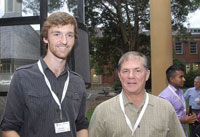



Next Generation of Poultry Scientists
AUSTRALIA - In addition to larger sub-projects being undertaken by Poultry CRC post-doctoral researchers, Poultry CRC supports a number of Honours, Masters and PhD students across participant universities. What follows is a short profile of five of these students; a brief outline of their projects and how they are progressing.Emma Bradbury

In her final year in Animal and Veterinary Bioscience at The University of Sydney, Emma attended lectures by Associate Professor Aaron Cowieson, sparking her interest in feed additives. Combining this with her interest in animal welfare, Emma is currently a Poultry CRC supported PhD student undertaking a project titled The Effect of Intermittent Feeding on the Behaviour and Energetic Efficiency of Broilers.
Her initial trials looked into a more digestible marine source of Calcium (Ca), and the effect of this on broiler leg health. Using this source of Ca, Emma used video cameras to monitor bird movements. Resulting bird activity can then be related to the diet’s effect on bird welfare status in terms of leg health. “I am still sorting through video footage from these trials. We did get some quite promising results,” said Ms Bradbury.
Following on from this, her current trials involve ‘choice’ feeding broilers two diets. Birds have ad lib access to both feed sources, with each diet containing varying levels of Ca and Phosphorus (P); the aim to see how birds are able to adapt and self-regulate their intake of these nutrients. “This will give us an idea of the driving force, Ca or P, behind their feeding preferences,” said Ms Bradbury.
In order to monitor the birds, she uses video cameras running 24/7 to capture bird time budgeting between feed sources (i.e. what time they are eating these types of foods and for how long). Using the results of the ‘choice’ feeding trials, Emma hopes to be able to formulate diets with optimum levels of P that enhance the digestibility of amino acids, maintain bird skeletal integrity (i.e. they won’t develop weak legs) and result in good Feed Conversion Ratios.
Linda Browning

With a background in the commercial world that includes seven years with Pfizer Animal Health, nine years with BASF and eleven and a half years with Roche/DSM, one could be forgiven for thinking that Linda Browning had already mapped a successful career path. However, for the past year, Ms Browning has added being a Poultry CRC supported PhD student at The University of Sydney, under the supervision of Associate Professor Aaron Cowieson. She has also held the position of President of the Poultry Research Foundation from 2006 to 2011.
Her project, The Effect of Vitamin D, Calcium (Ca), Phosphorus (P), Phytase and Strontium on leg health and egg shell quality in Poultry is set to deliver health benefits to poultry and human alike. “I have a passion and interest in Vitamin D, which is essential for both Ca and P transfer across the intestinal wall,” said Ms Browning. Vitamin D creates a carrier to transfer these elements and is responsible for 85 per cent of the Ca transfer, and more than 60 per cent of the P transfer.
“Together, Vitamin D, Ca and P go together to make a strong bone,” says Ms Browning. “In addition, there is another element that we don’t know much about called Strontium.” Strontium is present in very low levels in feed, but is also absorbed into bone and is also very much involved in Vitamin D production within the body itself.
Her experiments thus far have involved feeding different levels of Vitamin D and Strontium ‘in-feed’ to see if she can improve bone strength. In April, Ms Browning will start a new experiment in layers where she will try to get vitamin D into the egg yolk. “This is very important as the Australian population is chronically deficient in Vitamin D,” she said. She is hoping to get reasonable levels, close to levels recommended by the National Health and Medical Research Council, for our daily intake for Vitamin D into egg yolks, helping improve the general health of the population.
Pathum Dhanapala

Mr Dhanapala undertook his Bachelor of Science at Deakin University, then completed his honours studying human allergy at the molecular level, specifically looking at cytokines. He is now undertaking his PhD, titled Production and Characterisation of Hypoallergenic Chicken Eggs, in collaboration with Deakin University, CSIRO in Geelong and the Poultry CRC.
Globally, chicken egg allergy is the second most abundant food allergy behind cows’ milk. In Australia it ranks third behind peanut and milk allergies. “There are four specific proteins in the egg white that are allergens, namely ovalbumin, ovomucoid, lysozyme and ovotransferrin," said Mr Dhanapala. These allergens can trigger an allergic response in some people.
His research aims to initially characterise these four allergens. He hopes to then slightly modify the genetic structure of these allergens to effectively ‘switch off’ the allergenic part of the protein in the chicken egg white. These proteins will then be reintroduced into the egg in a non-allergenic form creating hypoallergenic eggs that will, in-turn, produce chickens that lay allergy-free eggs. “I really like working at CSIRO, and with the Poultry CRC,” he said. Mr Dhanapala sees his future in human allergy research, as he is very interested in this area.
Dean Powell

Mr Powell has taken up a PhD project with the Poultry CRC which has seen him recently leave Australia for a one year stretch in the United States of America. During this time he will work alongside Poultry CRC sub-project leader Professor Sandra Velleman at The Ohio State University. Professor Velleman is Mr Powell's immediate supervisor on his PhD project, Feed Restriction Effects on Broiler Muscle Growth.
The project seeks to understand the impacts of varied nutritional regimens on muscle development, especially in the first few weeks post-hatch, with the overall aim of producing broiler birds with more muscle and less fat. Muscle hypertrophy (increase in volume) occurs through the proliferation and differentiation of myogenic satellite cells, and Mr Powell explains his projects as “Trying to increase proliferation of satellite cells in the critical first couple of weeks of life.”
It has been shown that the nutritional status of the animal can cause these satellite cells to follow alternative pathways of differentiation, which can lead to intramuscular fat deposition and breast muscle fibre necrosis. Initial work will quantify the impact that various nutrient regimens have on the proliferation and differentiation of satellite cells. Subsequent studies will then allow Dean to test the practicality of these results when used to develop optimal nutritional strategies; the overall aim being to help increase economic returns per carcass in the commercial poultry industry.
Mr Powell has previously completed an Animal and Veterinary Bioscience degree, and an Honours project in beef genetics at The University of Sydney. He then looked to CRC’s for a PhD project that suited his interests and expertise. “I am very much looking forward to my time in the USA and working with Professor Velleman and the Poultry CRC,” he said.
Aaron Ray

Mr Ray has just commenced a Poultry CRC supported Honours project at the University of New England (UNE) after completing his Bachelor of Science (physiology and microbiology) degree. His Honours project, titled The Structural Basis of Egg Shell Translucency and Its Role in Food Safety of Table Eggs is under the supervision of Professor Julie Roberts, a Poultry CRC sub-project leader.
“The project will initially investigate the structure of eggs shells, and why translucent patches occur,” said Mr Ray. Subsequent to this, possible links between translucent patches and bacterial susceptibility will be quantified. Translucency of eggs can then be related back to food safety issues associated with eggs and egg products.
In order to investigate translucency, Mr Ray is making use of UNE’s CAT scanner and scanning electron microscope for this project. “This is the first time this equipment has been used for these types of applications,” he said. He is very interested in the imaging side of things, and is already looking to the future, with a PhD in mind. “This work may very well be in the poultry arena, as initial investigations using the CAT scanner have turned up interesting results that may warrant further research,” he added.








